Art & Study Retreats in Italy
In the Footsteps of Michelangelo
“So great is our innate love of learning and knowledge that no one can doubt that man’s nature is strongly attracted to these things without the incentive of any material gain.” Cicero, On Moral Ends 5. 18. 48
People have spiritual as well as material needs. We all delight in learning; we hunger for the self-transcendence that comes from experiencing beauty. And we crave the contemplative leisure and tranquility of soul that makes this experience possible.
We use the particular expertise and skills we have acquired from some thirty years of teaching, writing, painting, and living for shorter or longer periods in Italy to address these spiritual needs by organizing short art and study retreats in beautiful settings in Italian cities or in the countryside. Some retreats will consist of instruction in an art form, such as drawing, pastel painting and watercolor. Others will consist in the study of a particular topic, such as the life, times, and art of Michelangelo. We may even offer two at once, such as the study of Dante’s Divine Comedy and instruction in drawing, and offer participants the choice of either or both activities. Our goal is to give people a rest from today’s frenetic pace of life, and an opportunity to enrich their minds.
Michelangelo’s Italy
We’ve created “In the Footsteps of Michelangelo,” a fascinating art retreat and tour. We will focus on Michelangelo’s works, life, and times, including some of his more famous Renaissance predecessors such as Masaccio in painting and Donatello in sculpture.
We will host it at the Pensione Bencistà, in the hills east of Florence.
We will offer instruction on how to look at and appreciate artistic forms, especially painting and sculpture. Martha, as a practicing painter, can speak about the color and composition of works we’ll be viewing. We will also offer readings and on-site lectures on the theology, philosophy, and history of the Renaissance and the individual works of art we will see. Afternoons are free for you to explore Florence on you own, or just relax at the Bencistà. The goal of our Art Retreats in Italy is to provide the contemplative leisure people so desperately need today.
Martha and I will lead much of our excursion, but will also invite other scholars and art historians to give some on-site lectures in order to give you variety and other points of view.
Contact Us
If you would like more information, please call Prof. Robert Proctor at 860.442.6146
or send him an email at
write to him at
Robert Proctor
Art & Study Retreats in Italy
105 Oneco Avenue
New London, CT 06320-4120
Robert will respond to your inquiry as quickly as he can.
Faculty: Robert Proctor & Martha Wakeman
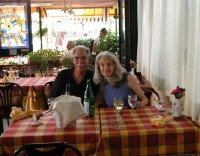
Robert Proctor and Martha Wakeman
[click image to enlarge]Robert E. Proctor is Joanne Toor Cummings ‘50 Professor of Italian at Connecticut College, where he has also served as Provost and Dean of the Faculty, and as Founding Director of the Toor Cummings Center for International Studies and the Liberal Arts. He is a member of the Board of Trustees of the Lyme Academy of Fine Arts, Old Lyme, Connecticut, and was Visiting Professor in 1999 - 2000, and fall 2001 with the goal of helping to integrate the humanities and fine arts curricula. He is also a member of the board of the Williams School, an independent 7 - 12 day school in New London, Connecticut.
Robert E. Proctor grew up in Los Angeles, California, and is a graduate of the University of San Francisco and of The Johns Hopkins University. He has been a fellow of Villa I Tatti, the Harvard University Center for Italian Renaissance Studies in Florence, Italy, and of The National Humanities Institute at Yale University. He is the author of Education’s Great Amnesia: Reconsidering the Humanities from Petrarch to Freud, with a Curriculum for Today’s Students (Indiana University Press, 1988), for which he won the Association of American Colleges’ Frederic W. Ness Book Award in 1990, given annually to the author of the book that contributes most to the understanding of liberal learning. A second paperback edition of the book appeared in 1998 with the new title Defining the Humanities: How Rediscovering a Tradition Can Improve Our Schools. He is now writing a book on the Roman origins of the liberal arts tradition.
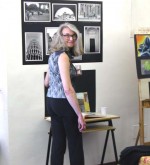
Martha Wakeman
[click image to enlarge]Martha Wakeman grew up in Darien, Connecticut. She graduated from Skidmore College in 1970 with a B.S. in Art Education, having spent one semester of her junior year at Tyler School of Art in Rome. She returned to Florence, Italy in the fall of 1970 to begin graduate work at Villa Schifanoia, Rosary College Graduate School of Fine Art. Thus began a ten-year period of life alone in a small rustic apartment in the hills outside of Florence. During this time she earned an MA and an MFA in painting, taught drawing and painting for Gonzaga University in Florence, and had numerous one-woman exhibits of her painting in Florence and Milan. 1979 brought her the opportunity to exhibit in New York.
In 1980, she came back to Connecticut and married Robert E. Proctor, professor of Italian language and literature at Connecticut College. Over the past 23 years, they have continued to return to Florence and Venice during the summer. These trips have provided a wealth of inspiration for Martha’s paintings. In Fall 2000, Martha and Robert traveled to Rome where Robert is creating an undergraduate program for Connecticut College on The Roman Origins of the Liberal Arts Tradition. They took Connecticut College students back to Rome again in the spring of 2002. The idea for a pastel course at Casa Ciotti was born when they first took their undergraduate students to Etruria under Mary Jane Cryan’s guidance.
Her life and many trips to Italy have provided a wealth of inspiration for Martha’s paintings. For many years she has been working on pastel landscapes inspired by Tuscany. She has now completed a series of cityscapes inspired by her recent stay in the charming Trastevere district of Rome.
Martha has exhibited in solo and group shows in Connecticut. Since 1984, she has taught drawing, painting, and pastel courses to Return to College Students at Connecticut College. During the summers of 2002 and 2003, she taught painting and pastel at The Umbra Institute in Perugia to college students from across the United States. Her work is in many private collections, in Europe, the United States, and Canada.
Martha Wakeman and Robert Proctor live in New London, Connecticut. They have two children, Rebecca and Andrew, ages 24 and 21.
Testimonials From Past Retreat Participants
From Maria Dewees:
My trip to Italy with Art and Study Retreats guided by Mr. and Mrs. Proctor was a wonderful experience, one that I will remember for many years. As a student in Professor Proctor’s classes: Italian Renaissance and Dante’s The Divine Comedy, I felt the material that I had been studying for months truly come to life before my eyes. Everywhere I looked was history and the characters I had read about: Michelangelo, Ghiberti, Dante, Cicero. Our visits to sites and museums were integrated with lectures that increased my appreciation and understanding of the material twofold. Mr. and Mrs. Proctor have a gift for conveying the breath and depth of their understanding of Italian art and culture. The complementary perspectives of a scholar and an artist were truly valued by the entire group. I think this was a very special trip for my mom and I to take together. I continue to appreciate Mr. and Mrs. Proctor’s constant dedication to all of their fellow travelers when I reflect upon my time with Art and Study Retreats in Italy.
From R. Dewees:
"In the Steps of Michelangelo” was a wonderful experience bringing my daughter and I closer together. We shared our love for art, culture, and history with a wonderful group of people. Professor Proctor never tired of answering questions and brought to life ancient myths and historical figures. My appreciation of art history increased with each fresco and sculpture we viewed with highly accomplished artist herself, Marty Proctor. Her mastery of the Italian language and succinct use of art terminology kept us visually inspired as well as intellectually stimulated. Robert and Marty tirelessly shared their past 30+ years of travel and study, with the gusto of teenagers seeing Italy for the first time. The Proctors are dynamic hosts for those who want to live in the beauty and truth of ancient Rome and walk “In the steps of Michelangelo."
From Charlotte and Ron:
Ron and I enjoyed the stimulating company, the smallness of the group and the marvelous way you integrated classic reading with what we are seeing!! A fabulous trip.
Venues: In the Footsteps of Michelangelo
This course/tour will focus on Michelangelo’s works, life, and times, including some of his more famous Renaissance predecessors, such as Masaccio in painting and Donatello in sculpture. What better place to do it than in the area where Michelangelo himself spent so much time.
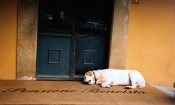 We will host it at the Pensione Bencistà, in the hills east of Florence. The Bencistà may be the last family-run inn in Florence. It is a Renaissance villa with terraces looking down on the city in the valley below. From here you can see clearly just all of Florence, including the Duomo, the tower of the Palazzo Vecchio, the church of Santa Maria Novella. There are sitting rooms and libraries and long winding halls; it’s an ideal setting for the kind of “art and study retreats” we want to create in Italy.
We will host it at the Pensione Bencistà, in the hills east of Florence. The Bencistà may be the last family-run inn in Florence. It is a Renaissance villa with terraces looking down on the city in the valley below. From here you can see clearly just all of Florence, including the Duomo, the tower of the Palazzo Vecchio, the church of Santa Maria Novella. There are sitting rooms and libraries and long winding halls; it’s an ideal setting for the kind of “art and study retreats” we want to create in Italy.
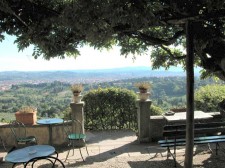 We’ve been going to the Bencistà with our children for about 15 years now. We often have—literally—a room with a view. Carla and Simone, the friendly owners, and their daughter and son-in-law Beatrice and Daniele, are delighted to host about 20 of us, at mezza pensione, which means breakfast and dinner—or lunch if you want to dine in Florence in the evening. The food is excellent, often Tuscan country cooking.
We’ve been going to the Bencistà with our children for about 15 years now. We often have—literally—a room with a view. Carla and Simone, the friendly owners, and their daughter and son-in-law Beatrice and Daniele, are delighted to host about 20 of us, at mezza pensione, which means breakfast and dinner—or lunch if you want to dine in Florence in the evening. The food is excellent, often Tuscan country cooking.
Afternoons are free for you to explore Florence on you own, or just relax at the Bencistà. The goal of our Art and Study Retreats in Italy is to provide the contemplative leisure people so desperately need today.
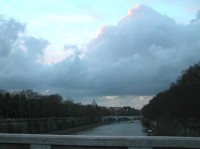 The tour begins and ends with a stay at Hotel Ponte Sisto, “our” four-star hotel in Rome. The rooms are beautiful, as is the location in the center of Renaissance and Baroque Rome, on the right bank of the Tiber, next to Ponte Sisto, the most beautiful bridge in Rome.
The tour begins and ends with a stay at Hotel Ponte Sisto, “our” four-star hotel in Rome. The rooms are beautiful, as is the location in the center of Renaissance and Baroque Rome, on the right bank of the Tiber, next to Ponte Sisto, the most beautiful bridge in Rome.
Itinerary: In the Footsteps of Michelangelo
Spend your days absorbed in the art of the Italian Renaissance
Day One: Morning arrival in Rome.
We’ll stay at Hotel Ponte Sisto, “our” four-star hotel in Rome. The rooms are beautiful, as is the location in the center of Renaissance and Baroque Rome, on the right bank of the Tiber, next to Ponte Sisto, the most beautiful bridge in Rome. Hotel Ponte Sisto is the perfect place to shower and rest after an all-night flight across the Atlantic. We’ll have a welcoming dinner in Trastevere at Mario’s, where we feel we’re part of the family. On our first night in Rome, we’ll walk across Ponte Sisto to get to Mario’s on the other side, and pause at the center of the bridge to look at Michelangelo’s Dome of St. Peter’s in the distance, silhouetted against the night sky in the west.
Before supper we’ll walk up to the Campidiglio, the Capitoline Hill, to see Michelangelo’s Renaissance redesign of the square and the surrounding buildings. From here we can look south down over the Forum and northwest to St. Peter’s. In the fading light we can conjure up images of ancient and Renaissance Rome, as Georgina Masson suggests in her excellent Companion Guide to Rome.
Day Two: Greek and Roman Sculpture and Michelangelo’s Moses and The Risen Christ
This morning in the Galleria Monte Martini we’ll discuss the nature of Greek and Roman sculpture, the classical tradition that Michelangelo emulated. Afterwards our vans will take us to the church of San Pietro in Vincoli (St. Peter in Chains) to see the Moses Michelangelo created for the tomb of Julius II. As we look at Moses we’ll ask what distinguishes this work from the Greek and Roman statues Michelangelo emulated. In other words, what is “Renaissance” about Michelangelo’s Moses?
Not too far from Hotel Ponte Sisto is the Pantheon, and next to the Pantheon is the only Gothic church in Rome, the Dominican church of Santa Maria sopra Minvera, (St. Mary’s above the Temple of Minvera). This church hosts Michelangelo’s “The Risen Christ,” with its classical body, as well as one of my favorite side chapels in Rome, the Carafa Chapel, in which the Florentine artist Filippino Lippi painted scenes which highlight St. Thomas Aquinas, the great Domenican theologian of the Middle Ages who so influenced Dante’s thought. The emphasis on books and the intellectual life in these scenes is a wonderful preparation for seeing Raphael’s Stanze della Segnature, which he decorated as Pope Julius II private library, in the Vatican.
Hotel Ponte Sisto is very near Palazzo Farnese. On our walk back from Santa Maria sopra Minerva we can pause and contemplate the façade Michelangelo created for this palace, now the French embassy in Rome, and marvel at the ability of one man to excel in sculpture, painting, and architecture.
Day Three: Medieval and Renaissance Themes
Morning departure by private coach for Perugia: Fontana Maggiore, College del Cambio, lunch at ristorante La Piazzetta, Pensione Bencistà, Fiesole (Florence)
There’s an Italian saying, Roma non basta una vita, “one life isn’t enough for Rome.” The same is true of Italy. I’ve been visiting or living in Italy almost yearly since I spent my junior year abroad in Florence in 1965–66, and I’m still discovering new riches! The city of Perugia is one of them. It sits on a hilltop across the valley from Assisi. Henry James named Perugia “the little City of the infinite View” because he believed that the view up the long vista of the Tiber valley, past Assisi, Spello, Foligno, Spoleto, almost to Rome herself, was the most beautiful you’re ever likely to see anywhere in the world.
In Perugia, we’ll look at Perugino’s frescoes in the Collegio del Cambio, the Bankers’ Guild. Here Perugino decorated the walls of the guild’s Hall of Justice with six Greek and Roman philosophers and legislators and six Greek and Roman warriors to exemplify the four classical virtues of prudence, justice, temperance, and fortitude. Because these figures share the room with the three Christian virtues of faith, hope, and charity, allegorized in scenes from the life of Christ, they are a wonderful example of the creative tension between the classical and Judeo-Christian traditions that characterized the Renaissance. Perugino was Raphael’s teacher. When we tour the Vatican Museums we’ll be able to compare Perugino’s frescoes here in Perugia with Raphael’s “The School of Athens” in the Stanza della Segnatura. The Sistine Chapel contains Perugino’s “Christ Giving the Keys to Peter,” one of my favorite paintings, not to mention Michelangelo’s mixing of Hebrew prophets and classical sibyls on the Sistine ceiling, a continuation of the Renaissance’s fusion, exemplified in the Collegio del Cambio, of the classical and the Judeo-Christian.
The Collegio del Cambio is on Corso Vannucci, the central street in Perugia, where, because there are no cars, people can stroll back and forth from the cathedral down to the park and ramparts that look out over the valley, the view Henry James described in his moving description of the week he spent in Perugia. A short walk from the Collegio del Cambio up Corso Vannucci takes us to the Galleria nazionale dell’Umbria, where we’ll look at works by Piero della Francesca, Fra Angelico, and Perugino.
Just beyond the Galleria is Perugia’s central square, Piazza IV Novembre, where stands one of the most beautiful and artistically important fountains in all of Italy, the Fontana Maggiore, created in the late 13th century by Giovanni and Nicola Pisano. Its statues and bas-reliefs, which include scenes from the Bible, Roman history, the months, and the seven liberal arts, show the medieval penchant for presenting all knowledge, including world history, in one unified work of art. The Fontana Maggiore is in some ways a sculptural parallel to Dante’s Divine Comedy.
We’ll have lunch in the upper, vaulted room of Ristorante La Piazzetta, a short walk away. La Piazzetta is our favorite restaurant in Perugia.
We’ll leave for Florence after lunch, and arrive at the Pensione Bencistà in Fiesole in time for supper.
Our schedule in Florence
We’d like to look at works of art in the city in the morning (we’ll have vans bring us back and forth from Fiesole. It’s about a 10–15 minute drive down the hill into the center of the city; the city bus takes about 20 minutes), and leave you free in the afternoons, and evenings. Some afternoon at the Bencistà I’ll be happy to read and discuss with anyone interested selections from Dante’s Divine Comedy as we sit on the terrace and look down over Dante’s city lighted by the setting sun.
On one of the evenings at the Bencistà we’ll have a woodwind concert before supper in the main drawing room. Two of the musicians, Paolo Nardi and Anita Garriott are old friends of Martha’s. Paola was first oboe and Anita first clarinet in the Teatro Comunale orchestra of Florence.
Day Four: From Dante’s Middle Ages to Michelangelo’s Renaissance
Baptistery: Mosaic ceiling: Dante and the Medieval worldview
Museo dell’ Opera del Duomo: “The Gates of Paradise,” Ghiberti’s panels from the Baptistery; Donatello’s prophets and Mary Magdalene; Michelangelo’s Florence Pietà.
The Museo dell’Opera del Duomo, in the area next to the Duomo where marble and other building materials were originally stored, is one of our favorite museums in Florence: the hurried tourists skip it. The museum contains two of our favorite statues. The first is Donatello’s Mary Magdalene, in which you can actually see in the eyes, hands, and emaciated body of an almost toothless old woman how beautiful her body once was and how much more beautiful her soul still is. The statue brings tears to one’s eyes.
This museum also contains another of Michelangelo’s Pietàs. Here the face of Nicodemus, who is holding up the body of the dead Christ, is the face of Michelangelo. In our opinion, experiencing the unforgettable pathos and spirituality of these two statues is worth the whole trip! It was Michelangelo, by the way, who gave the names “The Gates of Paradise” to Lorenzo Ghiberti’s doors of the Baptistery, to be seen in this museum.
This little museum also exhibits the Hebrew prophets Donatello carved for the façade of the Duomo. Donatello, through his statues, played an important role in shaping Michelangelo’s artistic talent. Without the realism, naturalism, and classicism of Donatello’s sculptures to study and emulate, the young Michelangelo would probably have carved his marble blocks in a different way. As T. S. Eliot argues so well in his thought-provoking essay “Tradition and the Individual Talent,” all great artists both work within but at the same time add to and thus transform the traditions they inherit. The classical understanding of creativity is that no artist can create beauty outside of a tradition. Even an artist who rejects a tradition has something to push off against. What the Renaissance is really all about is how an artist engages in a creative and opened-ended dialogue with classical Greek and Roman subjects and forms, whether in literature or in the visual arts.
Day Five: Masaccio and the Birth of Renaissance painting
Scenes from the Life of St. Peter, Brancacci Chapel, Church of Santa Maria del Carmine. The Trinity, Church of Santa Maria Novella
The realism and naturalism that distinguishes Renaissance painting begins in large measure with Masaccio. His frescoes on the Life of St. Peter in the Brancacci Chapel, moreover, depict the people and architecture of early Renaissance Florence as they must have been. His beautiful fresco of the Trinity in the Dominican church of Santa Maria Novella, with God the Father, framed under a Roman triumphal arch, supporting the cross on which Jesus hangs, shows well the Renaissance fusion of classical artistic forms with Judeo-Christian theology, a fusion animated by the creative tension between these two powerful but different thought worlds. We will have already seen this creative tension in the Collegio del Cambio in Perugia and will see its fullest resolution in the Sistine Chapel in Rome.
Day Six: From Donatello to Michelangelo
Bargello Museum, Accademia
The Bargello, once the city’s Palazzo del Popolo or Town Hall, and then a prison, is now a national museum that houses some beautiful works of art, among which are Donatello’s St. George and David, and Michelangelo’s The Drunken Bacchus and Brutus, not to mention the two competition panels for the doors of the Baptistery, Brunelleschi’s and Ghiberti’s (winning) The Sacrifice of Isaac. We’ll use our time in the Bargello to talk about the development of the art of sculpture from Donatello (1386–1466) to Michelangelo (1475–1564).
The Museo dell’Accademia contains Michelangelo’s David, Slaves, and St. Matthew.
Day Seven: Michelangelo’s Melancholy
Medici Tombs, Palazzo Rucellai
We’ll leave the Bencistà after breakfast and have our drivers take us directly to the Church of San Lorenzo, a Romanesque church rebuilt by Brunelleschi with funds from Cosimo de’ Medici and his father to become the Medici family mausoleum in Florence. The tombs Michelangelo carved here for two minor Medici rulers, Giuliano, the Duke of Nemours, brother to the Medici Pope Leo X, and Lorenzo, Duke of Urbino, the Pope’s nephew, are two of the most profoundly beautiful but melancholy works of art ever created. Perhaps they signal the end of the Renaissance. They certainly epitomize Michelangelo’s life-long obsession with the passage of time and with physical death.
After visiting the Medici Tombs, we’ll have a tour of Palazzo Rucellai, the façade of which, designed by the Renaissance architect and polymath Gian Battista Alberti, is considered the perfect example of the new “classical” architecture in “Renaissance” (“rebirth” of classical antiquity) Florence. Palazzo Rucellai now hosts the American school Palazzo Rucellai: The Institute of the Fine and Liberal Arts in Florence, to which Connecticut College sends students and whose President and CEO, Daniel Tartaglia, we know well. The Rucellai family still own the palazzo, although they’ve moved upstairs. We’ll see classrooms with frescoed ceilings so beautiful you want to teach in them (maybe we will—for you!)
Day Eight: The Great Renaissance Synthesis of Classical Forms and Judeo-Christian Beliefs
Morning departure by private coach for Rome. Afternoon private tour of Vatican Museums: Belvedere Sculpture Court, Raphael’s Stanza della Segnatura, Sistine Chapel. Hotel Ponte Sisto
Michelangelo traveled from Florence to Rome. So, too, do we. We return to Rome now able to look at Michelangelo’s Roman works after having seen his Florentine ones, as well as works by some of the artists, such as Masaccio, Donatello, and Alberti, who helped to create the tradition of Renaissance classical sculpture, painting, and architecture, a tradition in which Michelangelo grew up. Some of you will have also read with me selections from Dante’s and Michelangelo’s poetry, so you’ll be prepared for the terror and pathos of his Last Judgment in the Sistine Chapel.
We’ll visit the Vatican in the late afternoon for a private tour that will let us see the three famous Graeco-Roman sculptures that so influenced Renaissance sculptors, including Michelangelo: the Apollo Belvedere, the Laocoon, and the Hercules Torso. Afterwards we’ll go upstairs to visit the rooms Raphael decorated for Pope Julius II, and then walk down the long and breathtaking corridor of maps get to the Sistine Chapel, which we’ll have all to ourselves! I can tell you from personal experience that there’s a world of difference between seeing the Sistine Chapel in the midst of hordes of tourists and during a private visit.
Day Nine: Michelangelo and the Basilica di San Pietro
The St. Peter’s Basilica and the Pietà. Arrivederci Michelangelo dinner. Hotel Ponte Sisto
Today, our last day in Rome, we’ll see Michelangelo’s famous and moving Pietà in St. Peter’s, a work he completed in Rome in his mid twenties at the same time he was sculpting the very “pagan” Drunken Bacchus that we saw in the Bargello Museum in Florence. We’ll also visit the Basilica of St. Peter’s, and discuss Michelangelo’s work there as an architect. We’ll say “Arrivederci Michelangelo” at a farewell dinner in the evening.
Day Ten: morning departure
Summary: In the Footsteps of Michelangelo
Rome – Perugia – Florence – Rome
Departure from the United States
Day One, morning arrival in Rome
Michelangelo’s Campidoglio at dusk, supper at Mario’s in Trastevere. Hotel Ponte Sisto
Day Two, Michelangelo in Rome
Morning discussion of Greek and Roman sculpture, Galleria Monte San Martino; Michelangelo’s Moses, San Pietro in Vincoli. Hotel Ponte Sisto
Day Three, Medieval and Renaissance Themes
Morning departure by private coach for Perugia. Fontana Maggiore: Dante and the medieval summa. College del Cambio: Perugino’s classical and Christian virtues. Lunch at La Piazzetta restaurant. Afternoon departure for Florence. Supper at Pensione Bencistà, Fiesole (Florence)
Day Four, From Dante’s Middle Ages to Michelangelo’s Renaissance
Baptistery: Mosaic ceiling: Dante and the Medieval worldview. Museo dell’ Opera del Duomo: “The Gates of Paradise,” Ghiberti’s panels from the Baptistery; Donatello’s prophets and Mary Magdalene; Michelangelo’s Pietà. Pensione Bencistà
Day Five, Masaccio and the Birth of Renaissance painting
Scenes from the Life of Peter, Brancacci Chapel, Church of Santa Maria del Carmine. The Trinity, Church of Santa Maria Novella. Pensione Bencistà
Day Six, From Donatello to Michelangelo
Bargello Museum: Donatello, St. George, David; Michelangelo, The Drunken Bacchus, Brutus Accademia: Michelangelo, David, Slaves, St. Matthew. Pensione Bencistà
Day Seven, Michelangelo’s Melancholy
Medici Tombs, Basilica of San Lorenzo. Palazzo Rucellai: lecture on Michelangelo. Pensione Bencistà
Day Eight, The Vatican Museums: the Renaissance Synthesis of Classical Forms and Judeo-Christian Beliefs
Morning departure by private coach for Rome. Afternoon, private tour of Vatican Museums: Belvedere Sculpture Court, Raphael’s Stanza della Segnatura, Sistine Chapel. Hotel Ponte Sisto
Day Nine, Michelangelo and the Basilica di San Pietro
The St. Peter’s Basilica and the Pietà. Arrivederci Michelangelo dinner, Hotel Ponte Sisto
Day Ten, morning departure
